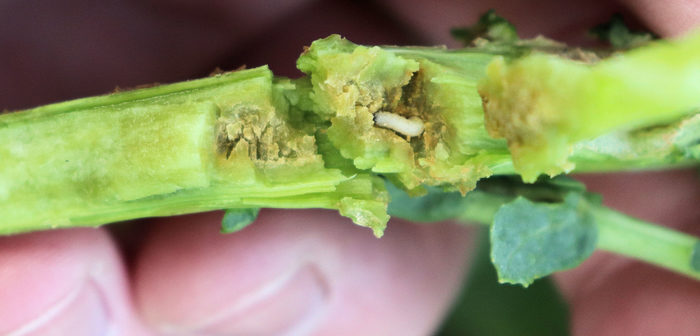A project to develop a biopesticide for Cabbage Stem Flea Beetle is looking to recruit farmers to help shape the eventual outcomes.
Funded by a grant from Innovate UK, Agri-Tech centre Crop Health and Protection (CHAP) is working in collaboration with CAB International (CABI) and Russell Bio Solutions Ltd, along with input from H&T Bioseed, to provide farmers with a much-needed alternative to the now banned neonic insecticides for cabbage stem flea beetle (CSFB), especially in the light of increasing resistance to Pyrethroids.
Oilseed rape (OSR) has for many years been the third largest arable crop in the UK, after wheat and barley. However, in 2019 the amount of OSR grown in the UK fell to 1,752,000 tonnes, down 12.9% from the 2,012,000 tonnes grown in 2018. This was the lowest yield in 5 years, due in part to the increasing prevalence of CSFB. The estimated cost of CSFB to growers in 2019 was £79M. With limited management tools left to control CSFB there is a market opportunity to develop a biopesticide.
The work to develop different formulations of a fungal biopesticide (identified in work already done by CHAP and CABI) to target CSFB in OSR at different stages of development kicks off today. Following on from this initial work, efforts will then progress into developing the scale up process.
The focus on end-user engagement will run alongside this development work and will involve two knowledge transfer workshops. The first will focus on the aim and objectives of the project, while the second will cover dissemination of results and technology adoption.
In addition, end-user feedback will be gathered using a market survey to ensure the project is aligned to end-user needs.
Dr Jenna Ross, International Business Development Manager at CHAP said, “CSFB damage is a massive challenge for OSR growers. This project is extremely timely and brings together leading scientists, innovators and businesses to develop a much-needed solution for the sector. And our focus on end-user farmer engagement is key for market adoption. We at CHAP are thrilled to be leading this project that aims to meet the OSR market demand and increase crop productivity while achieving net zero emissions and wider environmental and societal benefits.”
Dr Belinda Luke, Principal Scientist, Biopesticides Team, at CABI said: “The CABI Biopesticide Team are delighted to be able to provide growers of oilseed rape an alternative to neonics in their battle against CSFB. CABI have developed a few biopesticides over the past 25 years and it is great to work with H&T Bioseeds and Russell Bio Solutions to potentially get products on the market. With CHAP’s extensive UK network, it makes the perfect partnership for growers and scientists to come together to overcome the CSFB problem.”
Dr Nayem Hassan, Managing Director at Russel IPM, said: “The Russell IPM team is excited to develop a sustainable solution for CSFB in this challenging time when oilseed rape growers are unable to use many conventional chemicals. As a manufacturer of biological pesticides in the UK, we are really excited to see microbial technology becoming available to farmers to help them sustainably combat CSFB and avoid significant yield losses. We strongly believe that in collaboration with CABI, CHAP and H&T Bioseeds, we will be able to place a new alternative tool in growers’ hands to tackle CSFB effectively.”
Mr Paul Oliver, Managing Director at H&T Bioseed, said: “Biological solutions are an important component of future crop production. We are proud to be part of a project that has the potential to improve crop growth for farmers as well as provide better outcomes for our environment.”
The outputs of this project have the potential to significantly impact the UK economy by helping farmers increase yields through enhanced CSFB control. This project will also work towards achieving net zero emissions by 2040 through development of targeted biopesticides application systems. The wider environmental and societal benefits of this project include less damage to the environment and human/animal health due to reduction of chemical inputs.




